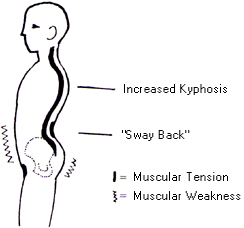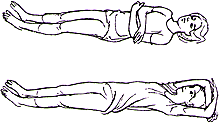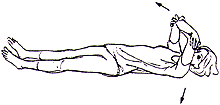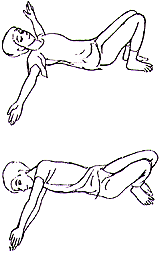Harriet Bucher, Physiotherapist, B. Sc.
Vienna/Austria
(certified YIDL teacher)
2004/January/26
Introduction
In our previous article about the eight-step-programme to prevent back pain, we showed how asanas (Yoga exercises) can help to prevent and cure neck problems. The holistic programme for prevention and ease of back pain is one branch of the “Yoga in Daily Life” system developed by Paramhans Swami Maheshwarananda.
The following article aims to provide information about the anatomy and correct posture of the Thoracic Spine. The suggested asanas are highly beneficial to the spine, and when practised regularly, help to keep the Thoracic Spine flexible and the muscles of this area strong.
The Thoracic Spine
The Thoracic Spine is the least mobile part of the spinal column. It lies between the Cervical and Lumbar Spine and is connected to the ribs. Any movement of the Thoracic Spine therefore causes activity in the two adjacent parts of the spinal column and also movement of the ribs. Within the Thoracic Spine, lateral movement and flexion are greater than extension or rotation. The main task of the Thoracic Spine is stabilisation. This segment of the spinal column must bear all impulse for movement that comes from the arms, legs or head to the Thoracic Spine, as well as stabilising and co-ordinating respiratory movement.
Postural Problems in the Region of the Thoracic Spine
A well erect Thoracic Spine is a prerequisite for free mobility of the ribs, shoulder blades and the Cervical and Lumbar Spine.
Back pain experienced in the Thoracic Spine area is generally caused by bad posture. The most common postural defect in the lower back is an increased curvature (Kyphosis) of the Thoracic Spine. In this position, the shoulder blades slouch forward and the front of the chest is narrowed. As a result, the shoulder blades and the respiratory system function less effectively and so the breath flow is impaired.
To maintain a healthy Thoracic Spine (upper back), exercises that strengthen the muscles of the lower back and stretch the chest muscles are particularly beneficial. In addition, the Thoracic Spine should be kept upright, whether sitting standing or doing exercise. In general, a correct posture can be maintained by ensuring the head is positioned correctly and the pelvis is held upright.

Picture 1 - Postural Problems in the Region of the Thoracic Spine
Physical Exercises (Asanas)
Before you start with the asanas, you should take some time to relax your body and your breath.
Stretching with arms crossed
Starting Position: Lie on your back. The eyes can be closed or open. The arms are crossed so that each hand grasps the elbow of the other arm.
Variation a:
- Inhaling raise the arms over the head – if possible onto the floor.
- Exhaling lower the arms onto the chest again.
- 3-5 times in rhythm with the breath

Picture 2 - Stretching with arms crossed (Variation a)
Points to Observe: The breath is slightly deeper than normal. Feel the stretching of the chest with the inhalation that continues down through the abdomen to the hips. Feel how the breath spreads into these areas.
Variation b:
- Inhaling raise the arms so that the elbows point towards the ceiling.
- Exhaling move the arms as far as possible to the right and at the same time turn the head to the left. You can use the right hand can to pull the left elbow a little.
- Inhaling move the arms and head to the centre.
- Exhaling moves the arms to the left and turn the head to the right.
- 3-5 times to each side, in rhythm with the breath.

Picture 3 - Stretching with arms crossed (Variation b)
Points to Observe: Extend your neck before you turn the head. The breath is slightly deeper than normal. You can also coordinate the turning (rotation) of the head with the movement of the eyes. This is a helpful impulse for the turning of the head and at the same time a good exercise for the eyes.
Variation c:
- Perform a large horizontal circle with your arms.
- Inhaling move the arms in a half-circle over the head.
- Exhaling continue the circle downwards.
- 3-5 times in rhythm with the breath, then repeat in the opposite direction.

Picture 4 - Stretching with arms crossed (Variation c)
Points to Observe: This variation is performed in the natural tempo of breathing, therefore it is somewhat dynamic. You can follow the movement of the arms with the eyes so that the head also performs a slight circular movement – this is beneficial for the eyes. Be conscious of the improved circulation of blood in the region of the shoulders, shoulder blades and the upper part of the back.
Benefits: Relaxes and improves circulation in the neck, the shoulders and the upper part of the back. Promotes mobility of the shoulders and ribs and deepens the breath in the front of the chest. Relaxes the eye muscles.
Caution: If lying on the back with straight legs causes pain in the region of the lumbar spine, then either bend the knees and place the soles of the feet on the floor, or place a small cushion under the Lumbar Spine or thighs. If turning the head causes dizziness, then keep the head centred.
Torsion (twisting) exercise with the arms
Starting Position: Lie on your back. The legs are bent and together. The arms lie out to the side at shoulder height and the palms face upwards.
All three Variations should be performed on each side.
Variation a:
- Inhale deeply into the abdomen and lengthen through the neck.
- Exhaling move the left hand in a vertical half-circle towards the right hand. The head also turns to the right side. The knees remain in the centre.
- Inhaling move the left arm and the head back to the starting position.
- Perform 3 times in rhythm with the breath.

Picture 5 - Torsion (twisting) exercise with the arms (Variation a)
Variation b:
- Inhale deeply into the abdomen.
- Exhaling again move the left hand towards the right hand and now also move both knees to the right. Pull the knees slightly towards the navel.
- Inhaling move the left hand in a vertical half-circle to the left side. The eyes and the head follow the movement of the arms. The legs remain on the right side.
- Exhaling again move the left hand to the right hand and then stretch the hands as far as is possible and comfortable to the front. Head and eyes follow the arm movement.
- Perform 3 times in rhythm with the breath.

Picture 6 - Torsion (twisting) exercise with the arms (Variation b)
Variation c:
- The arms are sideways at shoulder height on the floor. The legs are bent and lie to the right side.
- Inhale deeply into the abdomen.
- Exhaling move the left hand in a vertical half-circle to the right hand.
- Inhaling now move the left arm in a horizontal half-circle along the floor over the head to the left side.
- The eyes and the head follow the movement of the left hand.
- Perform 3 times in rhythm with the breath.

Picture 7 - Torsion (twisting) exercise with the arms (Variation c)
Relax lying on the back and feel the effects of these exercises. Observe how your back is now lying on the floor. (Very often after these Torsion exercises, the back lies flatter and more comfortably on the floor). Also be aware of how, with the inhalation, the chest is able to expand more easily and with the exhalation narrow again.
Benefits: Relaxes the entire musculature of the trunk and shoulders. Promotes mobility of the spinal column, the ribs and the shoulder joints. Relaxes and stretches the respiratory musculature and in this way has a deepening and harmonising effect on the breath. Relaxes the eye muscles. Encourages good coordination of breath and movement.
Preparation for Bhujangasan (Cobra)
Starting Position: Lie on the abdomen. The hands are clasped behind the sacrum. The palms face towards the head. The forehead lies on the floor.
- Inhaling press the pelvis (the groin area) towards the floor with the help of the buttock muscles and raise the head and upper body as far as is possible without causing pain. Extend the head backwards, but keep the neck long. At the same time lift the hands from the back and pull them towards the heels.
- Hold the position and the breath for a short while.
- Exhaling lower the upper body slowly.
- Repeat 4 times in rhythm with the breath and then on the 5th time remain in this position for 3-5 breaths.

Picture 8 - Preparation for Bhujangasan (Cobra)
Points to observe: Raise the upper body only to the degree that the movement remains pain free and specifically concentrate on the stretching of the upper region of the back. Breathe slowly and deeply. Following the exercise, remain for a short while on the abdomen and inhale deeply. Consciously guide the breath towards the lumbar spine and the sacrum.
Benefits: Strengthens the back and shoulder blade muscles and encourages extension of the Thoracic Spine. It is beneficial for “slipped disc” conditions and trains the musculature that is responsible for the stabilisation of the cervical spine. Deepens the breath and improves the digestion. Stimulates the circulation and function of all organs in the abdominal and pelvic regions and supports kidney function. Is very helpful for stress and anxiety, as this position counteracts the typical tension-conditioned position – rounding of the Cervical and Thoracic Spine and hunched-up shoulders, as well as shallow breathing.
Caution: The exercise should only be performed as long as it is pain free. Take particular care if you have osteoporosis, advanced arthrosis of the hip joints (wear and tear of the joints) and instability of the lumbar spine. If you suffer from high blood pressure or a weak heart this position should only be practised dynamically in rhythm with the breath, without holding the breath or remaining in the position for a long period of time.
Marjari asan (Cat) – Variation
Starting Position: Sit on your heels (Vajrasana). The back and neck form one straight line. The hands rest on the thighs and the eyes are closed. Be aware of the inhalation and exhalation in the abdomen and the back.
- Inhaling raise the arms forward to shoulder height and come up onto the knees keeping the back straight.
- Exhaling place the forearms on the floor. The elbows are beneath the shoulders. Upper arms and thighs form right angles to the floor. Round the back, like a cat, and look towards the navel.
- Inhaling extend the back and raise the head.
- Perform this back flexion and extension 3 times.
- Finish with the back curved upwards.
- Inhaling come up again onto the knees.
- Exhaling sit back on the heels.

Picture 9 - Marjari asan (Cat) – Variation
Points to observe: Pay attention to the Lumbar Spine when the back is rounded upwards, and to the “hanging” of the Thoracic Spine in the extended position.
Benefits: Improves mobility of the spine. This variation specifically promotes the extension of the Thoracic Spine, which is very important for good posture. Deepens the breath in the chest and abdomen and strengthens the diaphragm. It is a strain-relieving position for the pelvic organs.
Caution: This variation protects the Lumbar spine from overstretching. But even so, this position should not be practised if you suffer from osteoporosis, an acute slipped disc or instability of the Lumbar region of the spine. In this instance only bring the back down to the point where the back and neck form a straight line.
Materials presented here are presented in more detail in the book "YOGA AGAINST BACK PAIN" (original in German: Yoga gegen Rueckenschmerzen) by Mahamandaleshwar Paramhans Swami Maheshwarananda.
Although such papers and books are a valuable help and good source of information, they cannot entirely replace direct expert guidance, not to mention the diagnosing and treatment of more serious problems. Exercises described in this series are a very good prevention, helping to correct posture and alleviate minor back problems. Still, in case of more serious problems, you should first consult your physician about starting the exercises; exercises cannot be the only therapy in such cases.
